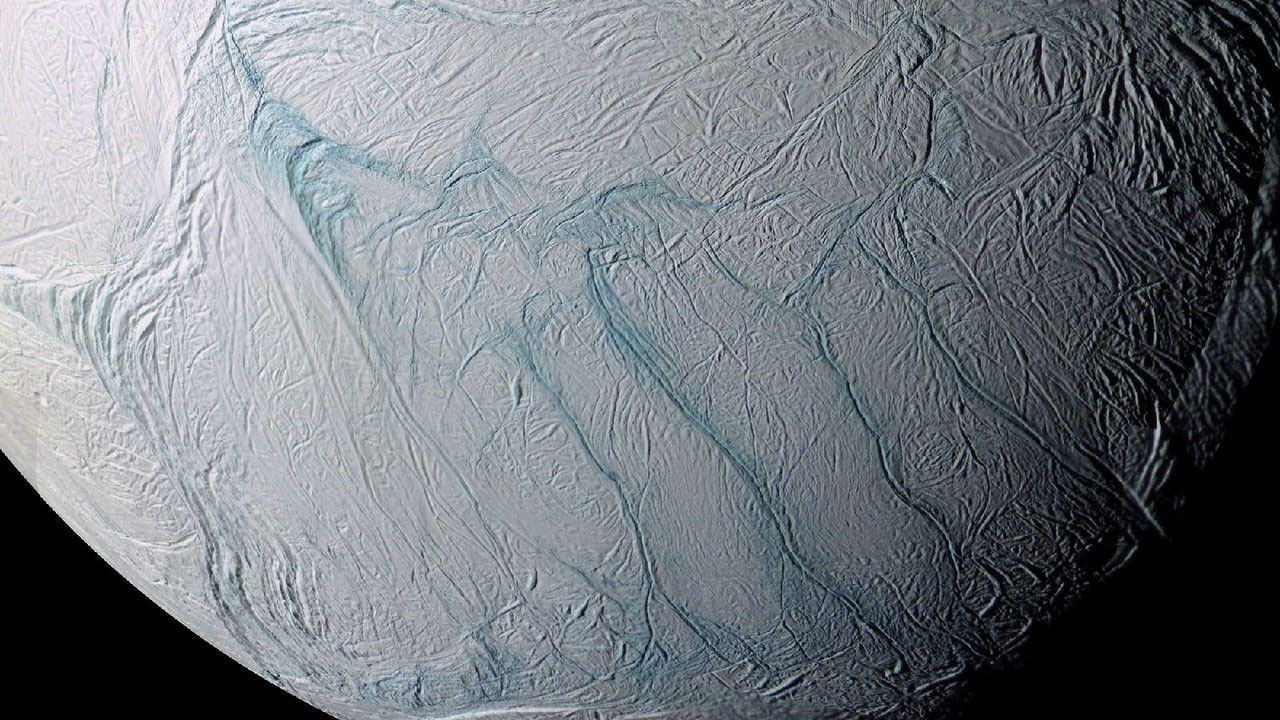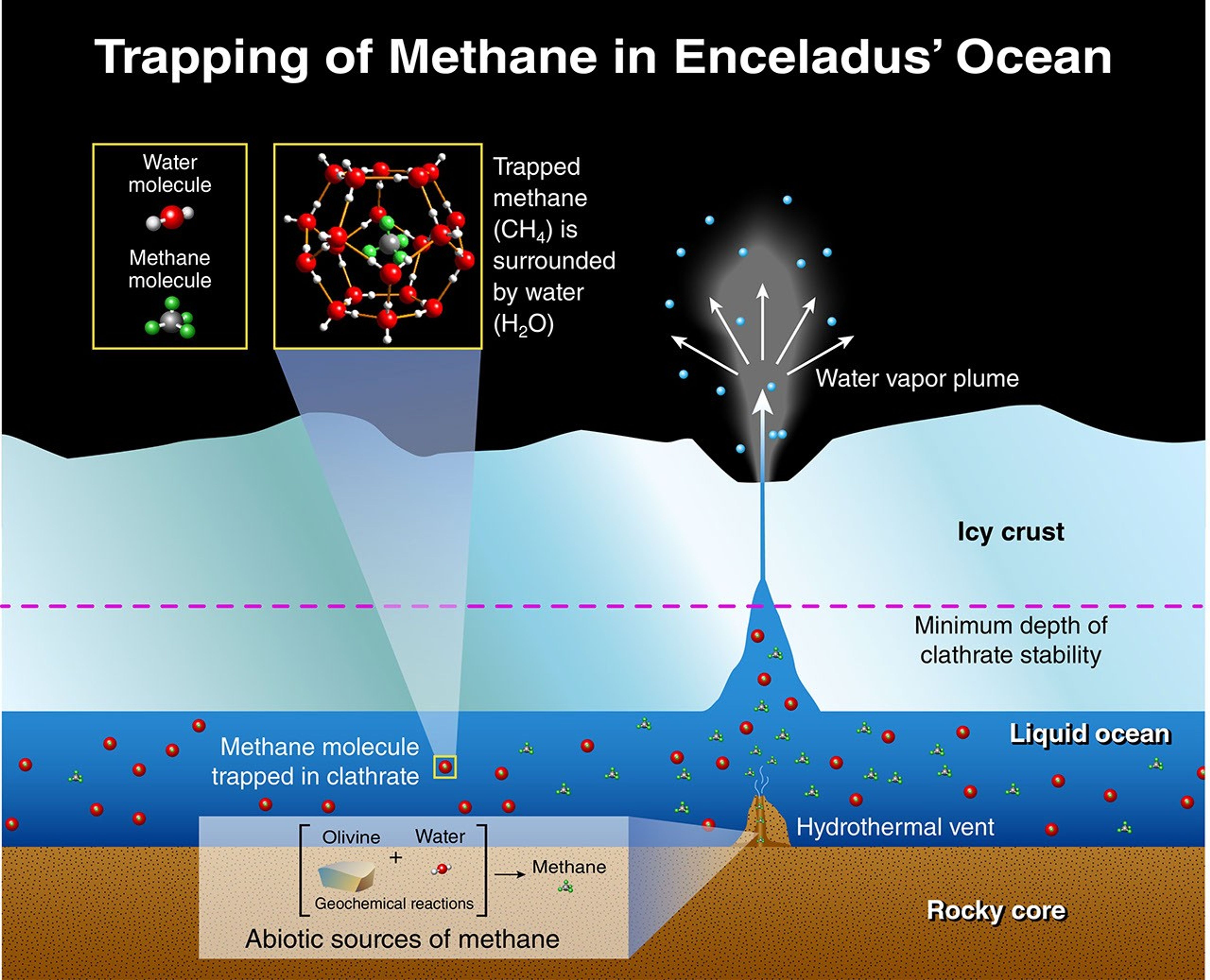Saturn’s moon Enceladus is just over 300 miles (500 kilometers) in diameter, not even half as wide as Pluto’s moon Charon. But despite its size, and despite the Saturn system being outside of what was thought to be our star’s habitable zone where liquid water can exist on a planet's surface, some scientists now think Enceladus is capable of harboring life.
The global ocean of Enceladus is likely as dark as a place can be, but is likely neither serene nor quiet. As Enceladus travels in its elliptical orbit about Saturn, the moon flexes as it gets nearer to its parent planet, then farther, then nearer again. Four great cracks known as the “tiger stripes” near its south pole spread, then squeeze and grind. Warm salt water, gases and minerals erupt through those fractures in the miles-thick ice shell and blast through the surface at 800 miles (1,300 kilometers) per hour into space.
Among all that activity, something else may be steadily burbling — a thing previously known to exist only on Earth. The Cassini mission has discovered evidence for hydrothermal vents in Enceladus.
“A lot of origin-of-life scientists believe that this is the place where life could have started on Earth.”- Morgan Cable, NASA JPL
“Around a hydrothermal vent on Earth, it’s dark because no sunlight reaches that deep in the ocean,” said Cassini project scientist Linda Spilker. “But, you have heat energy and nutrients shooting out, so you get lots of different kinds of life close to the vent.”
Where There’s Smoke
In some places on Earth, ocean water seeps deep into the seafloor where the subsurface is heated by magma. Hydrothermal vents are places where that hot, mineral-rich water erupts through the seafloor back into the ocean. The water churning forth is so thick with particles and dissolved minerals that it looks like smoke, which is why the chimney-like vents are called “black smokers,” along with their cousins, “white smokers.”
Black smokers tend to be the hotter of the two, reaching about 700 degrees Fahrenheit (about 350 degrees Celsius). Their “smoke” is black because it’s rich in iron sulfides and sulfides of other heavy metals. White smokers are less hot, around 100 to 200 degrees Fahrenheit (40 to 90 Celsius), and their “smoke” is closer to white because it’s rich in minerals composed of calcium and magnesium. On Earth, both types of hydrothermal vents have bustling ecosystems.
“They may be different but all hydrothermal vents tend to have not just bacteria and other microorganisms, but large, multicellular, complex organisms as well,” said Morgan Cable, a research scientist who studies ocean worlds at NASA’s Jet Propulsion Laboratory. Those organisms include crabs, octopi and tubeworms.
Confirming the presence of hydrothermal vents on another world is extraordinary, not simply because life can exist around them. “A lot of origin-of-life scientists believe that this is the place where life could have started on Earth,” Cable said. “So that gets us very excited about finding a place where conditions might not only allow for life to exist, but conditions that might allow for an origin of life as well.”
Rock Candy
No spacecraft has landed on Enceladus, drilled through its miles-thick ice shell or visited its seafloor to observe an extraterrestrial hydrothermal vent. But Enceladus has supplied Cassini with free samples of its ocean environment by steadily spraying ocean water into space where the spacecraft’s instruments can analyze it. And scientists have studied the environment around Earth’s hydrothermal vents for decades, which gives them a comparison for Cassini data.
From sampling the moon’s water jets and Saturn’s E ring (which is made of material from those jets), Cassini scientists have found three lines of evidence that suggest the moon's global ocean hosts active hydrothermal vents.
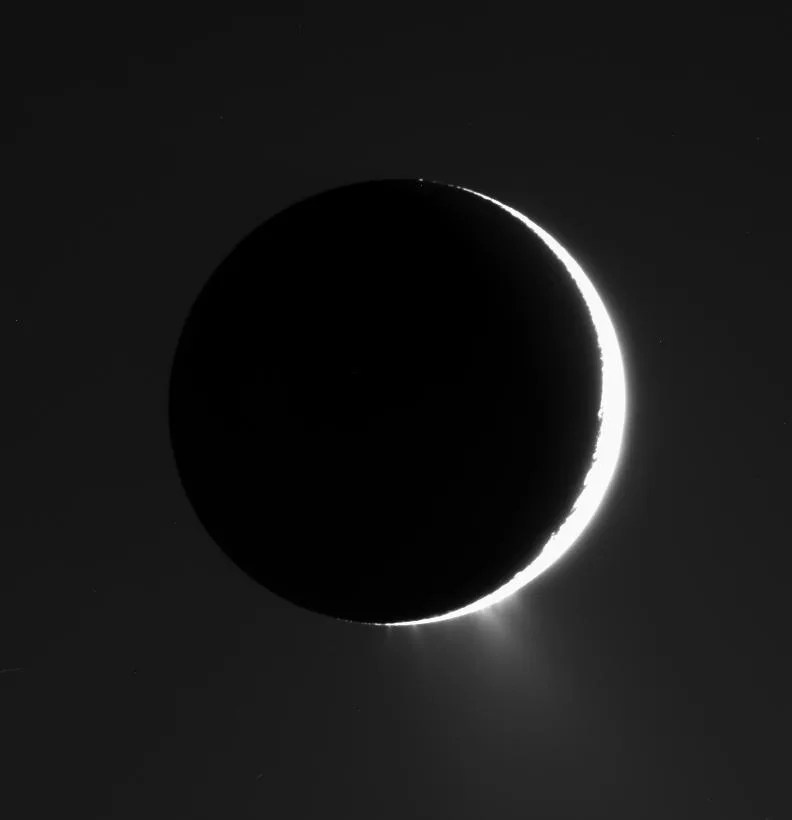 With Enceladus nearly in front of the Sun from Cassini's viewpoint, its icy jets become clearly visible against the background. Credit: NASA/JPL/SSI
With Enceladus nearly in front of the Sun from Cassini's viewpoint, its icy jets become clearly visible against the background. Credit: NASA/JPL/SSI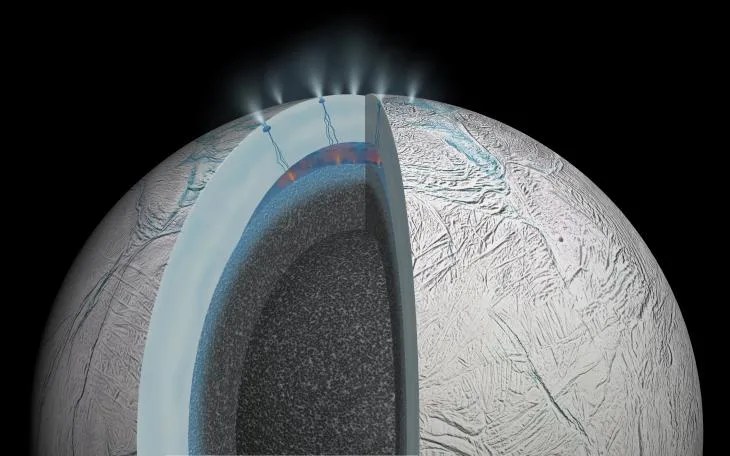 This cutaway view of Saturn's moon Enceladus is an artist's rendering that depicts possible hydrothermal activity. Credit: NASA/JPL-Caltech
This cutaway view of Saturn's moon Enceladus is an artist's rendering that depicts possible hydrothermal activity. Credit: NASA/JPL-Caltech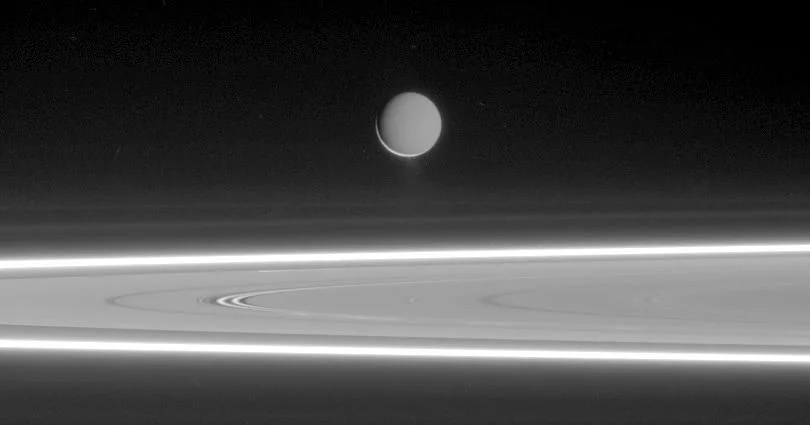 Lit by reflected light from Saturn, Enceladus appears to hover above the gleaming rings. Credit: NASA/JPL/SSI
Lit by reflected light from Saturn, Enceladus appears to hover above the gleaming rings. Credit: NASA/JPL/SSI
Released from ice particles in the plume, tiny bits of rock were discovered and analyzed by Cassini’s bucket-like Cosmic Dust Analyzer (CDA). After a four-year analysis of CDA data, combined with computer simulations and laboratory experiments, scientists determined that the grains were silica — the form of silicon that is commonly found in quartz sand on Earth.
They also concluded that the grains most likely form when hot water carrying dissolved minerals emerges from the seafloor into the much cooler ocean. Hot water can hold more dissolved material than cool water for the same reason that hot air can retain more water vapor than cool air.
When warm, humid air on Earth rises and cools, the water vapor condenses into clouds and sometimes rain. Though the materials are different, the principle is the same for hot, mineral-rich water emerging from hydrothermal vents into far colder water. “This causes certain chemicals, such as silicates, to precipitate from the fluid as small mineral particles,” said Chris Glein, a geochemist at the Southwest Research Institute who works with Cassini’s Ion and Neutral Mass Spectrometer (INMS) team. "Rock candy is formed in much the same way as when sugar is added to hot water and then allowed to cool."
The silica crystals sampled from the Enceladus plume were between two and eight nanometers (billionths of a meter) in diameter. “The only way that you can get grains of that size of pure silica is if they were formed in a salty water ocean and if they were exposed to temperatures of at least 90 degrees Celsius,” Cable said. That’s almost 200 degrees Fahrenheit. “That’s pretty hot —hydrothermal vent hot. White smoker hot.”
But silica crystals are just one line of evidence.
In addition to water and rock, other material is carried up in the plume including ammonia, carbon dioxide and methane. During multiple Cassini flybys, the INMS instrument analyzed plume material, but kept finding more methane than scientists had expected.
Scientists tried to come up with alternative scenarios to account for the excess methane, but none fit. Hydrothermal vents were simply the most likely source. “We see a lot of methane associated with hydrothermal vents on Earth, and so this gives us another line of evidence supporting hydrothermal activity,” Cable said.
A third line of evidence is the detection of molecular hydrogen (H2).
During the spacecraft’s final close flyby of Enceladus, Cassini flew through the plume at just 30 miles (49 kilometers) above the surface in October 2015 to determine if it contains any H2.
“Molecular hydrogen from the plume is very hard to measure,” Cable said. Some of the material in the spacecraft can release hydrogen and give Cassini’s sensitive instruments a false positive. “This really close flyby was intended to help with that,” Cable said.
In some hydrothermal vents on Earth, molecular hydrogen is produced at an extraordinary rate, and some organisms use it as food.
“Unlike the complex organic molecules we eat, like those in pizza, microbes in hydrothermal environments are perfectly happy feasting on inorganic compounds like molecular hydrogen, which are produced by geochemical reactions between water and rocks,” Glein said. “They are like buffets for microbes – the food just keeps coming!”
"A high abundance of hydrogen might also mean that the ocean has a high pH that would present a challenge for life." - Steve Vance, geophysicist at NASA JPL
While the presence of H2 is further evidence of hydrothermal vents, it doesn’t necessarily increase the likelihood of life flourishing in the Enceladean ocean, according to Steve Vance, a geophysicist at NASA’s Jet Propulsion Laboratory. “It might mean that there’s food that bacteria can eat, but a high abundance of hydrogen might also mean that the ocean has a high pH that would present a challenge for life.”
Time Unknown
Using knowledge of life and its environments on Earth, scientists can begin determining the habitability of other worlds. Figuring out the time required for life to spring up, however, is more difficult. “It’s something we don’t have a lot of information on because none of us were around when life started on Earth,” Cable said.
Scientists can study fossils of trilobites or dinosaurs, but the simplest lifeforms, like the ones that started it all, don’t fossilize well because they’re soft and microscopic. Even if they were preserved through fossilization, Earth is active — ancient meteor impacts, wind and rain, plate tectonics, volcanic activity and life itself perpetually re-sculpt our planet’s surface, erasing geologic records of the past. That leaves few rocks on Earth more than 3 billion years old or so, and life is thought to have begun hundreds of millions of years earlier even than that.
Despite the challenges, scientists have for decades attempted to estimate how long it took for life to form from non-living matter. Their estimates change as scientists learn more and as computer models improve, but they also vary depending on the environment where life might have begun. For example, if life began in tidal pools, it may have taken between a few hundred thousand years and a few million years for life to get started once all the ingredients were present.
Scientists think an upper time limit for life originating on Earth is somewhere around 25 million years. During the geologic period in which life began, massive meteorites collided with Earth every 25 million years or so, and the impacts were so destructive that they’d interrupt the changing chemistry that would eventually become the reproducing and self-preserving stuff of life. The chemical process would then have to start over. So, on Earth at least, molecules had to transform from almost-life to life within 25 million years or not at all.
And if life began in or around hydrothermal vents? “Let’s say you have all the ingredients for life there, but no life yet. Wait about 10 million years and you should have life,” Cable said. And the liquid water, the heat, and the inferred hydrothermal activity on Enceladus have been going on for 40 million years or more. Maybe more than 100 million years. If you compare that against the 10 million years, there’s plenty of time for life to have emerged,” Cable said. “It seems like all the ingredients are there. The question is: Is life there?”
A Fresh Set of Eyes
“The next step is to go fishing so to speak, but in a very methodical manner,” said Glein. The Cassini spacecraft launched in 1997 equipped with the technology of its time, and scientists didn’t then know Enceladus had a plume, an ocean or hydrothermal vents, so they didn’t include instruments on the spacecraft capable of detecting evidence of life, such as proteins.
In the future, scientists would like to send a new mission to Enceladus equipped to detect evidence of life that Cassini wasn’t built to see. “We're confident we could do this because the plume provides access to samples of Enceladus’ ocean,” Glein said.
“To find life elsewhere in our own solar system would be tremendous,” said Spilker. “But to find the possibility of life in the outer solar system is a complete paradigm shift with Cassini.”



























